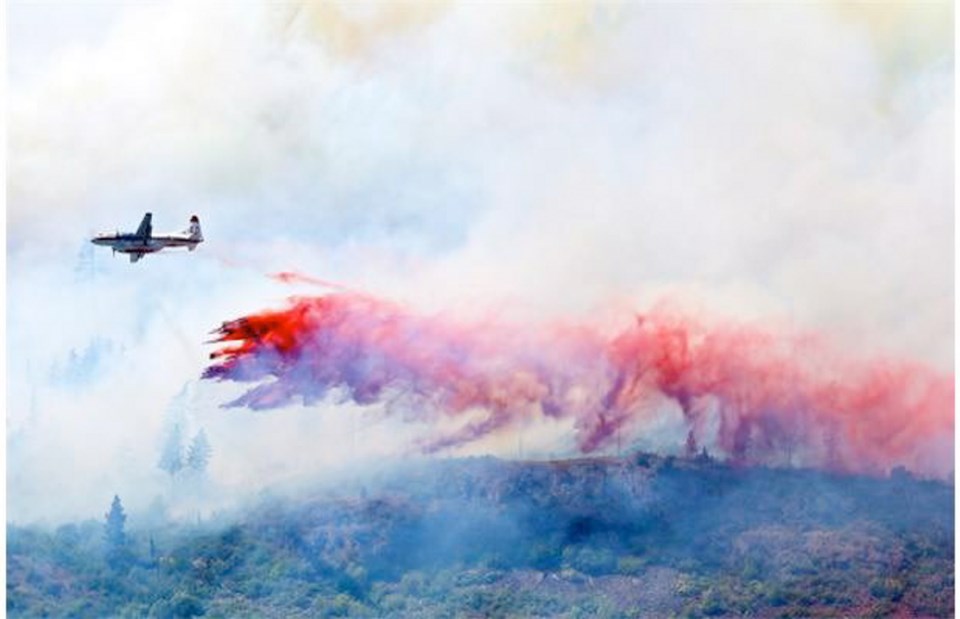LYTTON — The winds in the Fraser Canyon gust so strongly at times that it can be difficult to carry on a conversation with someone standing just a few steps away. That makes a wildfire on the steep mountain slopes here particularly hard to fight.
From a helicopter above the Cisco Road fire on Tuesday, ghostly wisps of white smoke could be seen drifting over scorched trees. As the southerly winds picked up speed, orange bursts of flame erupted here and there in the trees at the fire’s edges, sending off thick copper clouds.
Passengers in this chopper were warned to keep quiet as forest protection technician Scott Rennick checked out the fire’s progress and directed air traffic from above. A total of 11 helicopters were assigned to deal with the fire that day, and as the person in charge of operations, it was Rennick’s job to keep them working in harmony.
Some dropped water on the flames, but at least one chopper was literally fighting fire with fire. Positioned down below the edges of the blaze, the helicopter dangled a torch that dripped bright flames onto the trees, creating a burn line in the hope of keeping the wildfire contained.
In the early days of the Cisco Road fire, just south of Lytton, gusts reached up to 80 km/h, allowing the fire to spread quickly over rough terrain that was in many places too difficult for ground crews to reach. In response, firefighters have been setting controlled burns from the ground and air to burn up potential fuels in the fire’s path and stop the spread.
As of Friday afternoon, the fire’s size was estimated at 1,885 hectares, and firefighters had it 35-per-cent contained. With high temperatures and wind gusts of up to 70 km/h in the forecast through to the end of the week, though, officials don’t expect to get it under control any time soon.
“In this part of the province — around Lytton — wind is a huge factor in fire behaviour. We see unpredictable wind direction, as well as wind gusts,” said B.C. Wildfire Management Branch information officer Kayla Pepper.
Because no lightning strikes were recorded in the area at the time the blaze was sparked, investigators believe the fire was started by human behaviour. The exact cause is still under investigation. In a region this dry and windy, though, just about anything could start a wildfire.
“Because we’re in this part of B.C., it burns because it wants to burn,” Pepper said.
Though progress has been slow, Tuesday marked a breakthrough for the firefighting efforts. For the first time since the blaze was discovered on June 11, air tankers were able to get up in the air and drop bright red retardant on the flames.
Before then, the turbulence had simply been too rough, but conditions were now good enough that the biggest tanker in the province’s 24-plane fleet, a Lockheed Electra, was able to make several passes over the fire.
Air attack officer Eric Antifaeff led the offensive in a small Turbo Commander 690A — the so-called “bird dog” for the air tanker team currently stationed in Kamloops. From the passenger’s seat, he determines whether it’s safe for the tankers to fly, then directs operations from the air, pointing out the best spots to drop retardant and making sure flight paths don’t cross.
The Fraser Canyon is one of the toughest places in the province to fly air tankers because of the rough terrain and high winds.
“It can get pretty rough up there sometimes, but if it gets too hard, you just call it off,” Antifaeff said.
One hundred and ninety-seven firefighters and support staff are now assigned to the fire, along with 12 helicopters and four pieces of heavy equipment.
The priority for the 20-person crews is to protect people’s homes and other structures. One (unoccupied) residence has been destroyed in the blaze and another 25 homes are under alert.
Between shifts, the firefighters head back to camp, a small, fully self-contained village set up beside an airstrip just north of Lytton. They sleep in tents, shower in trailers and load up on high-calorie meals that allow them to maintain their energy during hard days in the field.
Meanwhile, fire behaviour specialist Rory Colwell keeps a close eye on the weather and the fire, to predict what will happen next. So far, the fire has stuck mainly to the ground surface, but that could change.
“If we get a little bit more wind and the temperatures stay high ... there’ll be some spreading to the tops of the trees, some candling, short bursts,” he said.
Colwell expects firefighters will be in Lytton for some time to come.
The appearance of this wildfire in June, a month that is typically much rainier in Lytton, signals the possibility of a busy fire season ahead.
“It tends to stay very dry here in this part of the Fraser Canyon, and it is only early June. We’ve still got a couple solid months of summer and some hot, dry weather,” he said.
The province has already seen more than 450 active wildfires this year, compared to 270 by this time in 2014. In a normal year, fires rip through 10,000 to 15,000 hectares by mid-June, but this year 60,000 hectares have already burned — a number that has been inflated by the Cisco Road fire and the Little Bobtail Lake fire near Prince George.
Ã˝



